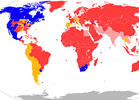
Chemist Raphael Mechoulam has passed away. He was 92.
Born in Bulgaria in 1930, Mechoulam spent his adult life in Israel. He's best known for synthesizing THC and other cannabinoids and discovering the endocannabinoid system (ECS).
Mechoulam was the Albert Hofmann of cannabis. (Hofmann discovered LSD.) In fact, Drug Policy Alliance founder Ethan Nadelmann made the same comparision when asked to comment about Mechoulam. "I can't help but think of Albert Hofmann when I think of Raphael Mechoulam," he tells CelebStoner. "Both were giants of psychoactive drug reserach who pioneered, led and legitimized the study of remarkable but controversial substances over the course of their very long and productive lives."
In a recent article in the Annual Review of Pharmacology and Toxicology, Mechoulam looked back at his life. After surviving World War II and the Holocaust (he father was placed in a concentration camp), he emigrated to Israel in 1949.
"In 1953 I was conscripted and spent about two years doing research in an Army medical research unit," he wrote. "Most of my work was in chemistry, in collaboration with pharmacologists. A few years later, I moved to the Hebrew University of Jerusalem, where I continued my research for the next 55 years."
Mechoulamn got in the ground floor of cannabis research: "My interest in natural products led me to read the literature on the chemistry and pharmacology of Cannabis. I was surprised to note that an active compound had apparently never been isolated in pure form and that its structure was only partially known. Even the structure of a major crystalline component, cannabidiol (CBD), which had been isolated more than two decades previously, was not fully elucidated. Their biological effects as pure or semipure compounds had barely been investigated."
He explained how they acquired cannabis to study it: "The administrative head of my Institute knew a police officer, who was presumably the number two (or possibly the number three) in the Israeli Police hierarchy. He phoned and told him that a Dr. Raphael Mechoulam needed hashish for research and that he - meaning me - was completely reliable (though he barely knew me). I just went to Police headquarters, had a cup of coffee with the policeman in charge of the storage of illicit drugs and got 5 kg of confiscated hashish, presumably smuggled from Lebanon."

This led to his discoveries of THC, CBD, cannabigerol (CBG), anandamide, 2-AG and eventually the ECS. "Although all the cannabinoids assayed were rather closely related chemically, only THC was active," he noted. "Hence, except for CBD and THC, very little research was published on the other cannabinoid constituents for a few decades. However, over the last few years, interest in them has increased."
In the mid-'80s, his colleague Allyn Howlett "reported the existence of a cannabinoid receptor, known today as CB1." They further concluded that THC and anandamide "represent the chemical basis of a new biochemical/physiological network: the endocannabinoid system. This system, as seen today, in addition to the two endocannabinoids, also covers the enzymes needed to synthesize and hydrolyze the endocannabinoids as well as two receptors: CB1 and CB2. The endocannabinoid system is of central importance in the animal body and represents an important modulatory network in the brain."
Mechoulam: "I had a cup of coffee with the policeman in charge of the storage of illicit drugs and got 5 kg of confiscated hashish, presumably smuggled from Lebanon."
That was huge news. In his "finals thoughts," Mechoulam speculated: "The endocannabinoid system is a latecomer to our knowledge in chemistry, pharmacology and physiology. Its involvement in biological processes is enormously wide, but most of the endogenous anandamide-like compounds and 2-AG-like compounds have yet to be investigated for their activity.
"I want to stress that in the endocannabinoid area, as well as in other areas, close collaboration between scientists working in medicinal chemistry and pharmacology is a wonderful and fruitful pathway to the discovery of novel biological traits. It has been a pleasure to work with my colleagues in Israel and abroad. I have learned a lot from them. And I hope to learn more.






